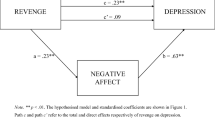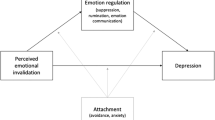Abstract
An inverse relationship exists between an individual’s degree of negative affect and the interpersonal perception of friendliness, sympathy and empathy, acceptance, warmth, regard, and genuineness, and the converse relationship persists for the perception of sadness and anger. Thus, a “negative interpersonal bias” exists in those with diagnoses of depression or dysphoria. There is evidence that psychostimulants (ie, amphetamine or methylphenidate) and antidepressants can reverse or improve these negative interpersonal perceptions in a positive way, especially in individuals with dysphoria, depression, and anxiety. The theoretic and therapeutic implications of these relationships are discussed herewith.
Similar content being viewed by others
References and Recommended Reading
Barrett-Lennard GT: Dimensions of therapist responses as causal factors in therapeutic change. Psychol Monogr 1962, 76:1–36.
McCann CD, Lalonde RN: Dysfunctional communication and depression: social cognitive processes. Am Behav Sci 1993, 36:271–287.
Carkhuff RR: Helping and Human Relations: A Primer for Lay and Professional Helpers, vol 2. New York: Rinehart and Winston; 1969.
Keijsers GP, Schaap CP, Hoogduin CA: The impact of interpersonal patient and therapist behavior on outcome in cognitive-behavior therapy: a review of empirical studies. Behav Modif 2000, 24:264–297. This paper suggests that, for cognitive therapy, perceptions of empathy, warmth, and genuineness in the therapist lead to greater improvement in the patient.
Chessick RD: How Psychotherapy Heals. New York: Science House; 1969.
Beck AT: Depression: Clinical, Experimental & Theoretical Aspects. New York: Harper and Row; 1967.
Beck AT, Rush AJ, Shaw BF, Emergy G: Cognitive Therapy of Depression. New York: Guilford; 1979.
Lewinsohn PM, Steinmetz JL, Larson DW, et al.: Depressionrelated cognitions: antecedent or consequence? J Abnorm Psychol 1981, 90:213–219.
Teasdale JD, Fogerty SJ: Differential effects of induced mood on retrieval of pleasant and unpleasant events from episodic memory. J Abnorm Psychol 1979, 83:248–257.
Matthews A, McLeod C: Cognitive approaches to emotion and emotional disorders. Annu Rev Psychol 1994, 45:25–50.
Hammen C: Cognitive, life stress, and interpersonal approaches to a developmental psychopathology model of depression. Dev Psychopathol 1992, 4:189–206.
Segal ZV, Williams JM, Teasdale JD, Gemar M: A cognitive science perspective on kindling and episode sensitization in recurrent affective disorder. Psychol Med 1996, 26:371–380.
Gurman AS: Effects of therapeutic mood on the therapeutic functioning of high and low-faciliative therapists. J Consul Clin Psychol 1973, 40:48–58.
Janowsky DS, Clopton J, Leichner PP, et al.: Interpersonal effects of marijuana. Arch Gen Psychiatry 1979, 36:781–785.
Pietromonaco PR, Rook KS, Lewis MA: Accuracy in perceptions of interpersonal interactions: effects of dysphoria, friendship, and similarity. J Pers Soc Psychol 1992, 63:247–259.
Essex MJ, Klein MH, Lohr MJ, Benjamin LS: Intimacy and depression in older women. Psychiatry 1985, 48:159–178.
Bouhuys AL, Bloem GM, Groothuis TGG: Induction of depressed and elated mood by music influences the perception of facial emotional expressions in healthy subjects. J Affect Disord 1995, 33:215–226.
Suslow T, Junghanns K, Arolt V: Detection of facial expressions of emotions in depression. Percept Mot Skills 2001, 92:857–868.
Bouhuys AL, Geerts E, Gordijn MC: Depressed patients’ perceptions of facial emotions in depressed and remitted states are associated with relapse: a longitudinal study. J Nerv Ment Dis 1999, 187:595–602. This study shows that when looking at ambiguous schematic drawings of facial emotions, depressed patients who saw more negative emotions were most likely to relapse.
Bouhuys AL, Geerts E, Gordijn MCM: Gender specific mechanisms associated with outcome of depression: perception of emotions, coping and interpersonal functioning. Psychiatry Res 1999, 85:247–261.
Bouhuys AL, Geerts E, Mersch PP: Relationship between perception of facial emotions and anxiety clinical depression: does anxiety-related perception predict persistence of depression? J Affect Disord 1997, 43:213–223.
George MS, Huggins T, McDermut W, et al.: Abnormal facial emotion recognition in depression: serial testing in an ultra-rapid-cycling patient. Behav Modif 1998, 22:192–204. This paper shows that the rapid change in mood states in a rapidly cycling patient is significantly related to changes in seeing a negative bias in schematic facial pictures.
Sloan DM, Bradley MM, Dimoulas E, Lang PJ: Looking at facial expressions: dysphoria and facial EMG. Biol Psychol 2002, 60:79–90.
Gilboa-Schechtman E, Erhard-Weiss D, Jeczemien P: Interpersonal deficits meet cognitive biases: memory for facial expressions in depressed and anxious men and women. Psychiatry Res 2002, 113:279–293.
Archer J, Hay DC, Young AW: Face processing in psychiatric conditions. Br J Clin Psychol 1992, 31:45–61.
Mandal MK, Palchoudhury S: Responses to facial expression of emotion in depression. Psychol Rep 1985, 56:653–654.
Geerts E, Bouhuys N: Multi-level prediction of short-term outcome of depression: non-verbal interpersonal processes, cognitions and personality traits. Psychiatry Res 1998, 79:59–72.
Janowsky DS, Kraft A, Clopton P, Huey L: Relationships of mood and interpersonal perceptions. Compr Psychiatry 1984, 20:546–551.
Janowsky DS, Clopton PL, Huey L, Judd LL: Effects of methylphenidate on interpersonal perceptions. Psychopharmacol Bull 1981, 17:183–185.
Janowsky DS, Clopton Pl, Huey LY, Judd LL: Effects of methylphenidate on interpersonal perceptions. In Recent Advances in Neuropsychopharmacology: Advances in the Bio-Sciences, vol 31. Edited by Angrist B. Oxford and New York: Pergamon Press; 1981:75–82.
McNair D, Lorr M, Droppleman L: EITS Manual for the Profile of Mood States. San Diego: Educational and Industrial Testing Service; 1971.
Katz MM, Waskow IE, Olsson J: Characterizing the psychological state produced by LSD. J Abnorm Psychol 1968, 73:1–14.
Harmer CJ, Bhagwagar Z, Perrett DI, et al.: Acute SSRI administration affects the processing of social cues in healthy volunteers. Neuropsychopharmacology 2003, 28:148–152.
Harmer CJ, Simon AH, Taylor MJ, et al.: Toward a neuropsychological theory of antidepressant drug action: increase in positive emotional bias after potentiation of norepinephrine activity. Am J Psychiatry 2003, 160:990–992. This study shows that roboxetine can acutely increase the processing of positively valenced materials in nondepressed volunteers. This finding allows an integration of psychotherapy and pharmacotherapy.
Covi L, Lipman RS: The relationship with a significant other as a criterion of improvement in a pharmacotherapy-psychotherapy trial. Presented at the Ninth Congress of the Collegium Interenationale Neuropsychopharmacologicum. Paris, France; July 7–12, 1974. Although from 1974, this is a very important presentation that linked a decrease in perception of interpersonal skills (ie, empathy, warmth, genuineness, and others) in a spouse or significant other to a patient’s depression.
Covi L, Lipman RS, Alarcon RD, Smoith VK: Drug and psychotherapy interactions in depression. Am J Psychiatry 1976, 133:502–508.
Beigel A, Murphy DL: Assessing clinical characteristics of the manic state. Am J Psychiatry 1971, 128:688–694.
Kesler A, Wewst ML, Andersen AH, et al.: Neural substrates of facial emotion processing using fMRI. Brain Res Cogn Brain Res 2001, 11:213.
Segrin C: Interpersonal reactions to dysphoria: the role of relationship with partner and perceptions of rejection. J Soc Pers Relat 1993, 10:83–97.
Segrin C, Abramson LY: Negative reactions to depressive behaviors: a communication theories analysis. J Abnorm Psychol 1994, 103:655–668.
Author information
Authors and Affiliations
Rights and permissions
About this article
Cite this article
Janowsky, D.S. Depression and dysphoria effects on the interpersonal perception of negative and positive moods and caring relationships: Effects of antidepressants, amphetamine, and methylphenidate. Curr Psychiatry Rep 5, 451–459 (2003). https://doi.org/10.1007/s11920-003-0084-3
Issue Date:
DOI: https://doi.org/10.1007/s11920-003-0084-3




